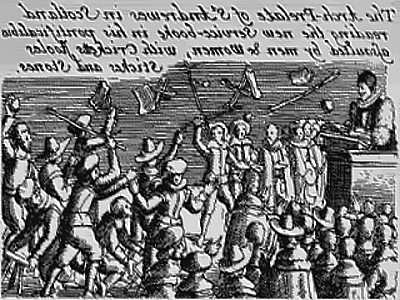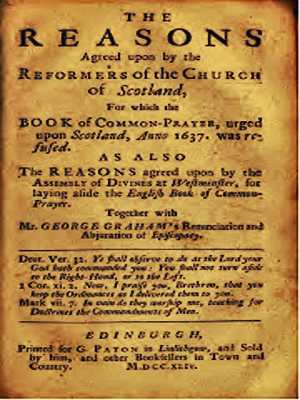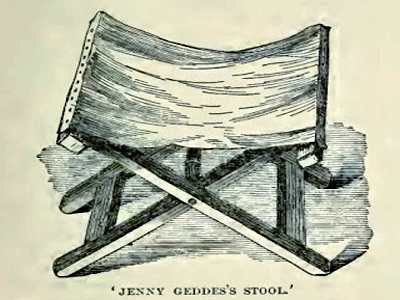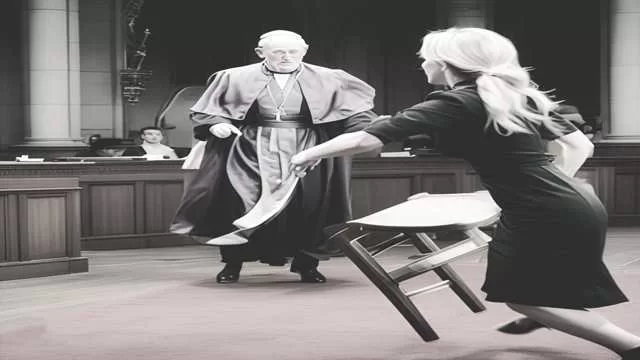How a Woman’s Stool Threw England into Chaos
History is often shaped by seemingly trivial incidents that lead to monumental consequences. One such event occurred in 1637 when a woman named Jenny Geddes threw a stool at a bishop during a church service in Edinburgh. This act of defiance ignited a series of events that would ultimately lead to the English Civil War and the execution of King Charles I.
Context of the Incident
To understand the significance of Geddes’s actions, we must first delve into the political and religious landscape of 17th-century England and Scotland. When King James I of England (and VI of Scotland) died in 1625, he passed on not only his throne but also his unwavering belief in the Divine Right of Kings to his son, Charles. Charles’s Scottish coronation in 1633 was fraught with tension, as many Scottish divines viewed the Anglican liturgy he employed as tainted by “Romanist Popery.”
Charles continued his father’s policy of Episcopalianism in Scotland, which favored church authority imposed by bishops, rather than the Presbyterianism preferred by many Scots. This tension was exacerbated by the appointment of William Laud as Archbishop of Canterbury, a man known for his disdain for Puritanism and his commitment to High Church practices.

In 1637, the introduction of a new prayer book, revised under Laud’s supervision, was met with widespread discontent. The Book of Common Prayer was to be used in Scottish churches, and its first reading at St. Giles Church in Edinburgh would become infamous.
Fateful Day
On July 23, 1637, as the Dean of Edinburgh, James Hannay, began to read from the new prayer book, the atmosphere in the church was charged with dissatisfaction. The male members of the congregation were seated in pews, while women, adhering to custom, occupied the aisles on stools they had brought with them. As Hannay read, murmurs of discontent grew louder until Jenny Geddes, a market seller, stood up and shouted, “De’il gie you colic the wame o’ ye, fause thief; daur ye say mass in my lug!” (The Devil give you cramps in your belly, false thief; dare you say mass in my ear).
In a moment of sheer defiance, she hurled her stool at Hannay’s head, igniting chaos in the church. The congregation erupted into a riot, throwing Bibles, sticks, stones, and more stools at the ministers. The Bishop of Edinburgh attempted to restore order, but the uproar continued, leading to a violent confrontation outside the church.
Aftermath
The incident marked the beginning of widespread unrest in Scotland. As the clerics left the church, they were followed by a jeering crowd, chanting, “Pull them down! A pope—a pope! Anti-Christ—Anti-Christ.” Rioting spread throughout Edinburgh, and the Earl of Roxborough, who had the Bishop in his carriage, narrowly escaped with his life.

In response to the growing unrest, King Charles I rejected calls to withdraw the Anglican liturgy in Scotland, which only fueled further riots. This led to the formation of the National Covenant, a document signed by the Covenanters—Presbyterians who opposed any changes to their form of worship. The Covenant was signed at Greyfriars Kirkyard in 1638, and its distribution across Scotland galvanized opposition to the King.
Bishops’ Wars
The tensions escalated into what became known as the Bishops’ Wars. Charles, determined to assert his authority, marched an army of 20,000 men north to confront the Covenanters. The initial skirmishes at Berwick in 1639 resulted in a stalemate, leading to a compromise that referred the matter back to the Scottish Parliament.
However, the conflict did not end there. Charles’s attempts to raise funds and troops through the Short Parliament in England were met with resistance, leading him to dissolve it. The subsequent Long Parliament further opposed the King, setting the stage for the Wars of the Three Kingdoms, which included the English Civil War.
Consequences
The fallout from Jenny Geddes’s act of defiance was profound. The conflict ultimately led to the execution of both King Charles I and Archbishop Laud on charges of treason. The Commonwealth, led by Oliver Cromwell, emerged from the chaos, marking a significant shift in the balance of power in England.

In retrospect, Jenny Geddes’s seemingly trivial act of throwing a stool at a bishop can be seen as the catalyst for a series of events that reshaped the political landscape of Britain. It serves as a reminder that history can pivot on the actions of individuals, no matter how small or insignificant they may seem.
Conclusion: A Legacy of Defiance
Jenny Geddes’s legacy endures as a symbol of resistance against authority and the fight for religious freedom. Her act of defiance in St. Giles Church not only sparked riots but also ignited a revolution that would change the course of British history.
As we reflect on this pivotal moment, we are reminded that even the smallest actions can have far-reaching consequences. In a world where the struggle for power and belief continues, Geddes’s story serves as an inspiration for those who dare to stand up against injustice, no matter the odds.

